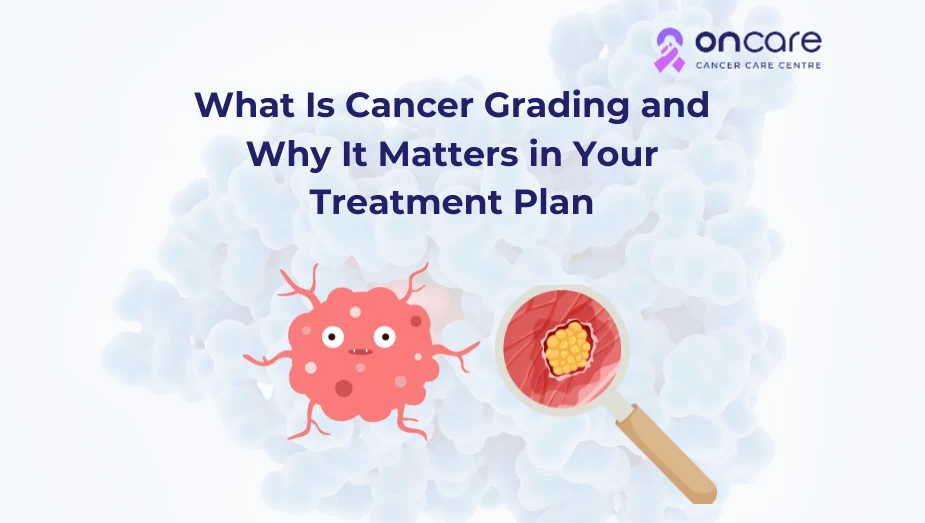Table of Contents
What Is Cancer Grading and Why It Matters in Your Treatment Plan

When facing a recent cancer diagnosis, understanding the cancer grading and its staging often feels overwhelming. There are factors that influence the treatment decisions, but among them, one of the most important factors is cancer grading. The term "cancer grading" plays a crucial role in determining how the cancer behaves, how it might respond to treatment, and ultimately the prognosis.
In this blog, we’ll discover more about the grading system of cancer, how it’s assessed, and why it’s a key component of developing a more personalized treatment plan.
What is cancer grading?
Cancer grading is a standard medical system that describes how cancer cells look under the microscope when compared to healthy cells. The pathologists often assign a particular grade after examining a tumor biopsy. The assigned grade generally gives clues about how quickly the cancer might grow and spread.
Here’s how the pathologist grades cancer in a patient.
These may include:
- Low - grade (Grade 1) : In this stage, the cells often look like normal cells, they tend to grow slowly, and usually less likely to spread quickly.
- Intermediate - grade (Grade 2) : In this stage, the cells usually look somewhat abnormal and might grow faster than normal than some low-grade cells.
- High- grade (Grade 3 or 4) : In this grade, the cells appear more abnormal and tend to grow faster than normal low-grade cells.
Why does cancer grading matter?
Cancer grading plays an essential role in shaping your cancer treatment journey.
Here’s why:
It helps to determine aggressiveness
A high-grade cancer often requires more intensive treatments, including a combination of surgery, chemotherapy, and radiation therapy. Low-grade cancers may be often monitored closely before aggressive measures are taken in the patients.
It guides to choose treatment options
In most cases, doctors use a grading system to decide the best treatment approach for patients. It used to focus on whether to use standard treatments, including surgery, or systemic treatments, such as chemotherapy.
It helps to predict prognosis
Generally, it is used to predict the prognosis in low-grade cancers, which have a better outlook than high-grade cancers, though this also depends on the stage and type of cancer.
It supports personalised treatments and care
Performing a grading in patients ensures that treatments are designed according to the tumor’s biology, avoiding both undertreatment and overtreatment.
The difference between cancer grading and cancer staging
While they may sound similar, cancer grading and staging are quite different.
Cancer grading | Cancer staging |
|---|---|
|
|
|
|
|
|
Both grading and staging are essential for a complete understanding of the disease.
Common grading systems
The different cancers have specific grading systems.
These may include:
Gleason score of prostate cancer (2-10)
It ranges from 2-10, with high scorers generally indicating more aggressive cancer. It is generally based on the microscopic appearance of cancer in the prostate glands.
Bloom-richardson system for breast cancer
This is another common grading system used for cancer also known as Nottingham grading system, it assesses the tumor based on the tubule formation, along with nuclear pleomorphism, and mitotic count.
Fuhrman grading system for kidney cancer
This is another type of cancer grading system for kidney cancer based on nuclear features, with higher grades indicating more aggressive cancers.
WHO grading for brain tumors (Grade I–IV)
This is another grading system used to classify brain tumors into four grades (I–IV), while grade I being the least aggressive and Grade being the most aggressive
What does cancer staging mean for you?
If your oncologist mentions the cancer grade and staging system, then don’t hesitate to ask these questions.
These may include:
- What grade is your cancer?
- How does it affect your cancer treatment?
- Does these cancer grades mean you need more aggressive cancer treatment?
- How do you monitor cancer progress?
Consult Today
Cancer staging is more than a medical label. It's a vital part of understanding the disease and choosing the best treatment path. Apart from cancer staging, it helps to predict how the cancer is going to behave and how doctors can best target it.
At Oncare, we offer premium quality cancer treatment including advanced cancer surgeries at affordable price ranges with an experienced cancer specialist consultation.
If you or any loved ones of yours are diagnosed with cancer, then visit Oncare Cancer Center and book an appointment with our cancer specialist. Get an estimated cost of cancer treatment.
Frequently Asked Questions
In most cases of cancer, the doctors need to know where the cancer is located and its extent. It usually helps to determine the treatment options. For instance, the best treatment for an early-stage cancer may come as surgery or radiation.
A more advanced stage of cancer may need treatments that may include all parts of the body, such as chemotherapy, targeted therapy, or immunotherapy.
The cancer is staged when it first gets diagnosed before any treatment is given. In some cases, the cancer is staged after the treatment is started.
Here’s how cancer is staged:
- Clinical staging
- Pathological staging
- Post- neoadjuvant therapy
- Recurrence or retreatment staging
There are different types of exams and tests can be used to determine the cancer’s stage.
- Physical examination
- Imaging tests
- Endoscopy exams
- Biopsy
- Lab tests
The most common type of staging system includes the TNM system. In the TNM system, the overall stage is decided after the cancer is assigned to a letter or number to describe the tumor (T), node (N), and metastasis categories.
- T describes the original (primary) tumor
- N describes whether the cancer has spread to the nearby lymph nodes
- M describes whether the cancer has spread (metastasized) to distant parts of the body.

